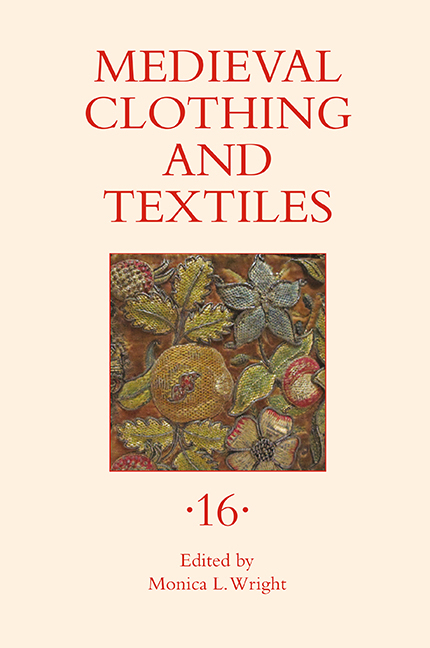Book contents
- Frontmatter
- Contents
- Illustrations
- Tables
- Contributors
- Preface
- 1 Anglo-Saxon Banners and Beowulf
- 2 The Use of Curved Templates in the Drawing of the Bayeux Tapestry
- 3 Construction and Reconstruction of the Past: The Medieval Nordic Textile Heritage of Hemp
- 4 Historicizing the Allegorical Eye: Reading Lady Mede
- 5 Sex, Lies, and Verdugados: Juana of Portugal and the Invention of Hoopskirts
- 6 Fashion and Material Culture in the Tabletop of the Seven Deadly Sins Attributed to Hieronymus Bosch
- 7 The Broderers’ Crown: The Examination and Reconstruction of a Sixteenth-Century City of London Livery Company Election Garland
- Appendix 7.1 Surviving Sixteenth-and Seventeenth-Century Embroidered Crowns of the City of London Livery Companies
- Recent Books of Interest
- Author Index, Volumes 1–15
Appendix 7.1 - Surviving Sixteenth-and Seventeenth-Century Embroidered Crowns of the City of London Livery Companies
Published online by Cambridge University Press: 27 March 2021
- Frontmatter
- Contents
- Illustrations
- Tables
- Contributors
- Preface
- 1 Anglo-Saxon Banners and Beowulf
- 2 The Use of Curved Templates in the Drawing of the Bayeux Tapestry
- 3 Construction and Reconstruction of the Past: The Medieval Nordic Textile Heritage of Hemp
- 4 Historicizing the Allegorical Eye: Reading Lady Mede
- 5 Sex, Lies, and Verdugados: Juana of Portugal and the Invention of Hoopskirts
- 6 Fashion and Material Culture in the Tabletop of the Seven Deadly Sins Attributed to Hieronymus Bosch
- 7 The Broderers’ Crown: The Examination and Reconstruction of a Sixteenth-Century City of London Livery Company Election Garland
- Appendix 7.1 Surviving Sixteenth-and Seventeenth-Century Embroidered Crowns of the City of London Livery Companies
- Recent Books of Interest
- Author Index, Volumes 1–15
Summary
The following embroidered garlands have remained as treasured possessions of their respective companies. Their frequent inclusion in exhibitions and publications highlights their respected status as works of art. Their survival provides a unique opportunity to study the development of professional embroidery, to note the changes in threads and progression of techniques over a century, and, potentially, to stimulate discussion and generate hypotheses.
For example, the metal thread known as pearl purl was used sparingly in this period, with many crowns using only the smoother lizerine. This may suggest that cost was a factor in the choice of thread; it may indicate a development in the production of drawn wire for embroidery; or perhaps the availability of metal thread was restricted during the seventeenth century. The presence of pearl purl also may indicate that a repair or replacement has been made to the original object, the original thread type (likely lizerine) not being available. Comparison with other extant embroideries may help to identify further details with regard to the date of production of other items of embroidery: A close examination of the damaged Girdlers’ Company crown (see section IV below) indicates that lizerine was used for the most part, pearl purl being used only for emphasis, while the reproduction, made in the twentieth century, does not use any lizerine at all, pearl purl being used throughout. Further examination and documentation over a larger body of embroidered artefacts employing a prescribed methodology will help to develop a more accurate timeline of materials, design, technique, and perhaps even makers.
THREE CROWNS OF THE BREWERS’ COMPANY
Date: 1629.
Approximate dimensions: Height 8 centimetres, diameter 20 centimetres.
Description: All three crowns are identical on the outside and have two appliquéd motifs of a maiden holding grain—thought to be Thomas Becket's stepmother (fig. 7.11), eight appliquéd heads of grain (fig. 7.12), two appliqued shields of the company arms (fig. 7.13), and embroidered borders at top and bottom of purl and couched cord, on a crimson velvet ground. Garnished at upper and lower edges with applied filé lace. The dates “1628 : 1629” are embroidered on the inside of every one with the initials HL (Henry Leake), IH (John Heylin), or HB (Henry Bridges).
- Type
- Chapter
- Information
- Medieval Clothing and Textiles 16 , pp. 191 - 204Publisher: Boydell & BrewerPrint publication year: 2020



